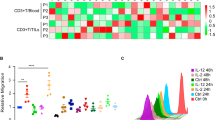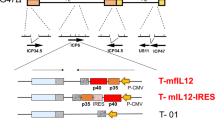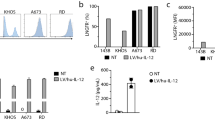Abstract
We report here that gene transfer using recombinant adenoviruses encoding interleukin (IL)-18 mutants induces potent antitumor activity in vivo. The precursor form of IL-18 (ProIL-18) is processed by caspase-1 to produce bioactive IL-18, but its cleavage by caspase-3 (CPP32) produces an inactive form. To prepare IL-18 molecules with an effective antitumor activity, a murine IL-18 mutant with the signal sequence of murine granulocyte-macrophage (GM)- colony stimulating factor (CSF) at the 5′-end of mature IL-18 cDNA (GMmIL-18) and human IL-18 mutant with the prepro leader sequence of trypsin (PPT), which is not cleaved by caspase-3 (PPThIL-18CPP32−), respectively, were constructed. Adenovirus vectors carrying GMmIL-18 or PPThIL-18CPP32− produced bioactive IL-18. Ad.GMmIL-18 had a more potent antitumor effect than Ad.mProIL-18 encoding immature IL-18 in renal cell adenocarcinoma (Renca) tumor-bearing mice. Tumor-specific cytotoxic T lymphocytes, the induction of Th1 cytokines, and an augmented natural killer (NK) cell activity were detected in Renca tumor-bearing mice treated with Ad.GMmIL-18. An immunohistological analysis revealed that CD4+ and CD8+ T cells abundantly infiltrated into tumors of mice treated with Ad.GMmIL-18. Huh-7 human hepatoma tumor growth in nude mice with a defect of T cell function was significantly inhibited by Ad.PPThIL-18CPP32− compared with Ad.hProIL-18 encoding immature IL-18. Nude mice treated with Ad.PPThIL-18CPP32− contained NK cells with increased cytotoxicity. The results suggest that the release of mature IL-18 in tumors is required for achieving an antitumor effect including tumor-specific cellular immunity and augmented NK cell-mediated cytotoxicity. These optimally designed IL-18 mutants could be useful for improving the antitumor effectiveness of wild-type IL-18.
This is a preview of subscription content, access via your institution
Access options
Subscribe to this journal
Receive 12 print issues and online access
$259.00 per year
only $21.58 per issue
Buy this article
- Purchase on Springer Link
- Instant access to full article PDF
Prices may be subject to local taxes which are calculated during checkout






Similar content being viewed by others
References
Okamura H, Tsutsi H, Komatsu T, et al. A novel cytokine that induces IFN-γ production by T cells. Nature. 1995;378:88–91.
Dinarello CA, Novick D, Puren AJ, et al. Overview of interleukin-18: more than an interferon-γ inducing factor. J Leuk Biol. 1998;63:658–664.
Nakanishi K, Yoshimoto T, Tsutsui H, Okamura H . Interleukin-18 regulates both Th1 and Th2 responses. Annu Rev Immunol. 2001;19:423–474.
Golab J . Interleukin 18 — interferon γ inducing factor — a novel player in tumor immunotherapy? Cytokine. 2000;12:332–338.
Stoll S, Muller G, Kurimoto M, et al. Production of IL-18 (IFN-γ-inducing factor) messenger RNA and functional protein by murine keratinocytes. J Immunol. 1997;159:298–302.
Udagawa N, Horwood NJ, Elliott J, et al. Interleukin-18 (interferon-γ-inducing factor) is produced by osteoblasts and acts via granulocyte/macrophage-stimulating factor and not via interferon-γ to inhibit osteoclast formation. J Exp Med. 1997;185:1005–1012.
Conti B, Jahng JW, Tinti C, et al. Induction of interferon-γ inducing factor in the adrenal cortex. J Biol Chem. 1997;272:2035–2037.
Cho D, Song H, Kim YM, et al. Endogenous interleukin-18 modulates immune escape of murine melanoma cells by regulating the expression of Fas ligand and reactive oxygen intermediates. Cancer Res. 2000;60:2703–2709.
Ghayur T, Banerjee S, Hugunin M, et al. Caspase-1 processes IFN-γ-inducing factor and regulates LPS-induced IFN-γ production. Nature. 1997;386:619–623.
Gu Y, Kuida K, Tsutsui H, et al. Activation of interferon-γ inducing factor mediated by interleukin-1β converting enzyme. Science. 1997;275:206–209.
Fantuzzi G, Dinallero CA . Interleukin-18 and interleukin-1 beta: two cytokines substrates for ICE (caspase-1). J Clin Immunol. 1999;19:1–11.
Akita K, Ohtsuki T, Nukada Y, et al. Involvement of caspase-1 and caspase-3 in the production and processing of mature human interleukin 18 in monocytic THP.1 cells. Biol Chem. 1997;272:26595–26603.
Osaki T, Hashimoto W, Gambotto A, et al. Potent antitumor effects mediated by local expression of the mature form of the interferon-γ inducing factor, interleukin-18 (IL-18). Gene Ther. 1999;6:808–815.
Yoshimura K, Hazama S, Iizuka N, et al. Successful immunogene therapy using colon cancer cells (colon 26) transfected with plasmid vector containing mature interleukin-18 cDNA and the Igκ leader sequence. Cancer Gene Ther. 2001;8:9–16.
Yoshida Y, Tasaki K, Kimurai M, et al. Antitumor effect of human pancreatic cancer cells transduced with cytokine genes which activate Th1 helper T cells. Anticancer Res. 1998;18:333–335.
Weitzman MD, Wilson JM, Eck SL . Adenovirus vectors in cancer gene therapy. In: Sobol RE and Scanlon KJ, eds. The Internet Book of Gene Therapy, Cancer Therapeutics. CJ, USA: Appleton & Lange; 1995: 17–25.
Seong YR, Choi S, Lim JS, et al. Immunogenicity of the E1E2 proteins of hepatitis C virus expressed by recombinant adenoviruses. Vaccine. 2001;19:2955–2964.
Vile RG, Russell SJ, Lemoine NR . Cancer gene therapy: hard lessons and new courses. Gene Ther. 2000;7:2–9.
Oshikawa K, Shi F, Rakhmilevich AL, et al. Synergistic inhibition of tumor growth in a murine mammary adenocarcinoma model by combinational gene therapy using IL-12, pro-IL-18, and IL-1β converting enzyme cDNA. Proc Natl Acad Sci USA. 1999;96:13351–13356.
Puren AJ, Fantuzzi G, Dinarello CA . Gene expression, synthesis, and secretion of interleukin 18 and interleukin 1β are differentially regulated in human blood mononuclear cells and mouse spleen cells. Proc Natl Acad Sci USA. 1999;96:2256–2261.
Perregaux D, McNiff P, Laliberte R, Conklyn M, Gabel CA . ATP acts as an agonist to promote stimulus-induced secretion of IL-1β and IL-18 in human blood. J Immunol. 2000;165:4615–4623.
Mehta VB, Hart J, Wewers MD . ATP-dependent release of interleukin (IL)-1β and IL-18 requires priming by lipopolysaccharide and is independent of caspase-1 cleavage. J Biol Chem. 2001;276:3820–3826.
Sanghyeon Kim, Suh KS, Seong YR, et al. Adenovirus-mediated mGM-CSF in vivo gene transfer inhibits tumor growth in a murine Meth A fibrosarcoma model. J Kor Soc Virol. 2000;30:141–150.
Hara S, Nagai H, Miyake H, et al. Secreted type of modified interleukin-18 gene transduction into mouse renal cell carcinoma cells induces systemic tumor immunity. J Urol. 2001;165:2039–2043.
Goto H, Osaki T, Nishino K, et al. Construction and analysis of new vector systems with improved interleukin-18 secretion in a xenogeneic human tumor model. J Immunother. 2002;25:S35–S41.
Nagai H, Hara I, Horikawa T, et al. Gene transfer of secreted-type modified interleukin-18 gene to B16F10 melanoma cells suppresses in vivo tumor growth through inhibition of tumor vessel formation. J Invest Dermatol. 2002;119:541–548.
Pirhonen J, Sareneva T, Julkunen I, Matikainen S . Virus infection induces proteolytic processing of IL-18 in human macrophages via caspase-1 and caspase-3 activation. Eur J Immunol. 2001;31:726–733.
Novick D, Kim SH, Fantuzzi G, et al. Interleukin-18 binding protein: a novel modulator of the Th1 cytokine response. Immunity. 1999;10:127–136.
Kim SH, Eisenstein M, Reznikov L, et al. Structural requirements of six naturally occurring isoform of the IL-18 binding protein to inhibit IL-18. Proc Natl Acad Sci USA. 2000;97:1190–1195.
Kim SH, Azam T, Yoon DY, et al. Site-specific mutations in the mature form of human IL-18 with enhanced biological activity and decreased neutralization by IL-18 binding protein. Proc Natl Acad Sci USA. 2001;98:3304–3309.
Ju DW, Yang Y, Tao Q, et al. Interleukin-18 gene transfer increases antitumor effects of suicide gene therapy through efficient induction of anitumor immunity. Gene Therapy. 2000;7:1672–1679.
Sgadari C, Angiolillo AL, Tosato G . Inhibition of angiogenesis by interleukin-12 is mediated by the interferon-inducible protein-10. Blood. 1996;87:3877–3882.
Coughlin CM, Salhany KE, Wysocka M, et al. Interleukin-12 and interleukin-18 synergistically induces murine tumor regression which involves inhibition of angiogenesis. J Clin Invest. 1998;101:1441–1452.
Cao R, Farnebo J, Kurimoto M, Cao Y . Interleukin-18 acts as an angiogenesis and tumor suppressor. FASEB J. 1999;13:2195–2202.
Yao L, Sgadari C, Furuke K, et al. Contribution of natural killer cells to inhibition of angiogenesis by interleukin-12. Blood. 1999;93:1612–1621.
Micallef MJ, Tanimoto T, Kohno K, Ikeda M, Kurimoto M . Interleukin 18 induces the sequential activation of natural killer cells and cytotoxic T lymphocytes to protect syngeneic mice from transplantation with Meth A sarcoma. Cancer Res. 1997;57:4557–4563.
Tanaka F, Hashimoto W, Okamura H, et al. Rapid generation of potent and tumor-specific cytotoxic T lymphocytes by interleukin-18 using dendritic cells and natural killer cells. Cancer Res. 2000;60:4838–4844.
Ju DW, Tao Q, Lou G, et al. Interleukin 18 transfection enhances antitumor immunity induced by dendritic cell-tumor cell conjugates. Cancer Res. 2001;61:3735–3740.
Acknowledgements
We thank Sanghyeon Kim for cloning of IL-18 cDNAs, and JS Lim and KD Kim for immunological assays.
This work was supported by a Grant (FG03-32-02) of 21C Frontier Functional Genome Project from the Ministry of Science and Technology, South Korea.
Kyung-Sun Hwang and Won-Kyung Cho have contributed equally to this work.
Author information
Authors and Affiliations
Corresponding author
Rights and permissions
About this article
Cite this article
Hwang, KS., Cho, WK., Yoo, J. et al. Adenovirus-mediated interleukin-18 mutant in vivo gene transfer inhibits tumor growth through the induction of T cell immunity and activation of natural killer cell cytotoxicity. Cancer Gene Ther 11, 397–407 (2004). https://doi.org/10.1038/sj.cgt.7700711
Received:
Published:
Issue Date:
DOI: https://doi.org/10.1038/sj.cgt.7700711
Keywords
This article is cited by
-
Strengthening of antitumor immune memory and prevention of thymic atrophy mediated by adenovirus expressing IL-12 and GM-CSF
Gene Therapy (2012)
-
Targeting of products of genes to tumor sites using adoptively transferred A-NK and T-LAK cells
Cancer Gene Therapy (2007)
-
Adenovirus-mediated interleukin-12 gene transfer combined with cytosine deaminase followed by 5-fluorocytosine treatment exerts potent antitumor activity in Renca tumor-bearing mice
BMC Cancer (2005)



